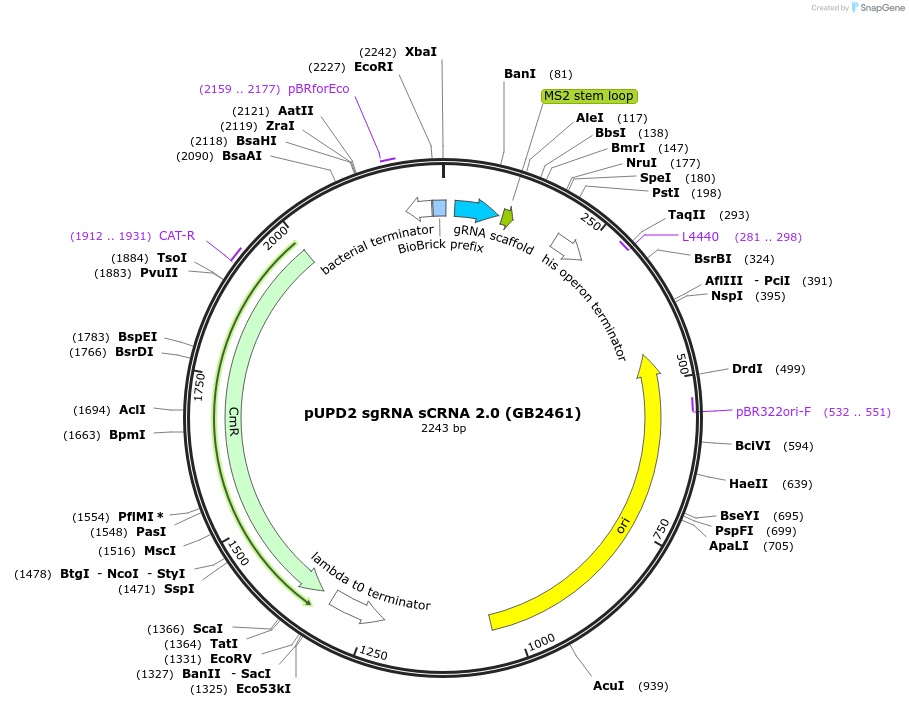pUPD2 sgRNA sCRNA 2.0 (GB2461)
(Plasmid
#160593)
-
PurposeVersion of the native Cas9-sgRNA with one native WT aptamer sequence and F6 aptamer sequence recognized for Ms2 coat protein, in 3'.
-
Depositing Lab
-
Sequence Information
Ordering
| Item | Catalog # | Description | Quantity | Price (USD) | |
|---|---|---|---|---|---|
| Plasmid | 160593 | Standard format: Plasmid sent in bacteria as agar stab | 1 | $85 | |
Backbone
-
Vector backbonepUPD2
-
Backbone manufacturerself-made; derived from the BioBrick assembly plasmid pSB1C3
-
Vector typeCRISPR
Growth in Bacteria
-
Bacterial Resistance(s)Chloramphenicol, 25 μg/mL
-
Growth Temperature37°C
-
Growth Strain(s)DH5alpha
-
Copy numberHigh Copy
Gene/Insert
-
Gene/Insert namesgRNA sCRNA 2.0
-
SpeciesUnspecified
-
Insert Size (bp)138
-
MutationBsaI and BsmBI sites removed
Cloning Information
- Cloning method Restriction Enzyme
- 5′ cloning site BsmBI (destroyed during cloning)
- 3′ cloning site BsmBI (destroyed during cloning)
- 5′ sequencing primer gctttcgctaaggatgatttctgg
- 3′ sequencing primer cagggtggtgacaccttgcc (Common Sequencing Primers)
Terms and Licenses
-
Academic/Nonprofit Terms
-
Industry Terms
- Not Available to Industry
Trademarks:
- Zeocin® is an InvivoGen trademark.
Depositor Comments
Compatible with GoldenBraid; insert can be released with BsaI
These plasmids were created by your colleagues. Please acknowledge the Principal Investigator, cite the article in which the plasmids were described, and include Addgene in the Materials and Methods of your future publications.
-
For your Materials & Methods section:
pUPD2 sgRNA sCRNA 2.0 (GB2461) was a gift from Diego Orzaez (Addgene plasmid # 160593 ; http://n2t.net/addgene:160593 ; RRID:Addgene_160593) -
For your References section:
Strong gene activation in plants with genome-wide specificity using a new orthogonal CRISPR/Cas9-based programmable transcriptional activator. Selma S, Bernabe-Orts JM, Vazquez-Vilar M, Diego-Martin B, Ajenjo M, Garcia-Carpintero V, Granell A, Orzaez D. Plant Biotechnol J. 2019 Sep;17(9):1703-1705. doi: 10.1111/pbi.13138. Epub 2019 May 23. 10.1111/pbi.13138 PubMed 31034138


